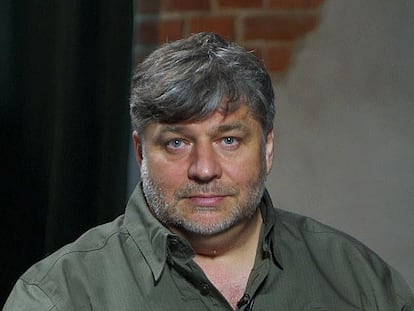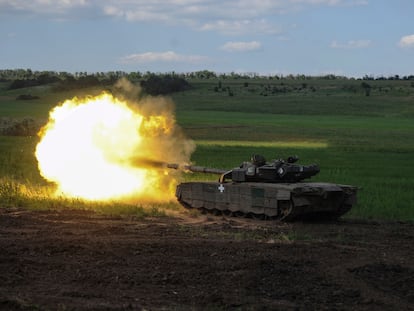Ukraine’s silence on counteroffensive gives Moscow an edge in war of information
Media and defense analysts are increasingly reliant on Russian military sources for reports on front line combat operations after Kyiv imposes news blackout

Silence. This is the code that the Ukrainian government and armed forces have been following since June, when the first stages of the counteroffensive were initiated. Two videos distributed by the Ministry of Defense eloquently reinforce the point: in the first one, released last week, soldiers from several military units look to the camera and ask, via a hand gesture, that people remain quiet and not give away any information about military operation. The second, from Sunday, shows the general in charge of the intelligence services, Kyrylo Budanov, staring at the camera for 30 seconds, without saying a word, with a superimposed slogan: “Plans love silence.” In the face of Kyiv’s information blackout — although the Ukrainian authorities have reported the liberation of several villages, especially in the Donetsk region — the media and defense analysts depend on Russian military sources.
Ukrainian society has abided by the law of silence because the future of the country is at stake in the counteroffensive. It is not only the military and the Ministry of Defense that have stopped transmitting information. Ukrainian national media, academics and defense analysts have also chosen to avoid assessing the evolution on the frontlines. Until a few weeks ago, thousands of Ukrainian soldiers offered daily videos and commentary on the war on social networks. This too has been put to an end.
International media and military analysts now rely on Russian sources of information at the front, particularly the Telegram accounts of commanders, pro-Russian analysis groups like Rybar, RusVesna or Grey Zone, Russian frontline journalists like Sasha Kots or Semion Pegov, and more controversial figures like Igor Girkin (a pro-Russian militia commander during the Donbas conflict who was convicted in absentia in the Netherlands for the downing of Malaysia Airlines flight MH17) or the leader of the Wagner Group, Yevgeny Prigozhin. Both Ukrainian citizens and international observers have details of Kyiv’s advances on the Donetsk and Zaporizhzhia fronts through these sources.
Ukrainian patriots “paying attention to Russian junk media”
This has worked to the Kremlin’s advantage, says Mikhail Samus, director of the defense think tank New Geopolitics: “In modern warfare, mastering information is a key element and the Russians are being very efficient. Through them we know that Leopard tanks have been destroyed. We haven’t said anything.” Samus warns that Russian propaganda essentially serves up lies — for example, giving a supposedly exaggerated number of Leopards eliminated on the battlefield — but adds the key to getting the message across is for there to be some element of truth to it. Media access to the front lines, to report on these issues and counter such propaganda, has been severely limited since the beginning of the war, especially on the Russian side. As of this year, the Ukrainian General Staff has introduced even more red tape for journalists.
What is certain is that via Russian information, the world knows that the armored vehicles provided to Ukraine by its NATO allies are already being deployed on the front lines. John Helin, an analyst at the Finnish Black Bird Group, confirms the Russian dominance in reporting on the war: “Defense analysts are relying heavily on this because they report on the evolution of the fighting, unlike Ukrainian sources. I think it is counterproductive for Ukraine’s interests, and the fact that they are remaining silent gives Russia an advantage in the information world.” Helin adds that even Ukrainian media accounts are using Russian sources for the first time. “It’s a simple rule: when you opt for silence, the audience starts listening to your enemy. We already have this problem. Even Ukrainian patriots are starting to pay attention to Russian junk media,” says Viktor Tregubov, a Ukrainian Army captain and communications expert.
Courtesy of Russian sources, the Ukrainian and international public is also aware of the advances being made by Ukrainian forces in Zaporizhzhia and the brigades involved. Russian observers have announced the liberation of villages in the border areas of Zaporizhzhia and Donetsk, even before the Ukrainian Armed Forces have. Girkin announced on Saturday that Neskuchne was in Ukrainian hands, a day before Kyiv issued an official statement. In other municipalities, such as Blahodatne or Makariivka, the same pattern has been followed. Rus Vesna reported on Monday that a Russian counteroffensive had been launched against Makariivka, even specifying the units involved.
Olha Husieva, an academic at the Institute for Security Policy at Kiel University, Germany, noted that she and her colleagues also rely on Russian sources: “The Ukrainian side has agreed to pay this price, to cede control of the story to Russia, in exchange for tactical benefits on the battlefield.” Husieva sees an obvious change in information strategy on the part of Kyiv, because until now it had always tried to direct media attention to its advantage; for example, in 2022, when it sent signals that a major attack was being prepared in Kherson while secretly preparing to liberate Kharkiv. “Now what we have is an information blackout,” Husieva says, because there are many plans underway to feel out Russian defenses and the presence of outside observers can be an advantage for the enemy. According to the expert, the Ukrainian General Staff has learned from the experience of the battle of Bakhmut, when the press had greater direct access to Ukrainian positions and instantly reported advances and setbacks. “They have learned that if they do not have a secured position, it is better not to rely on the media.”
Helin points out it inevitable that the international community wants up-to-date information — partly because of the billions of dollars donated to Ukraine in military aid — and defends unofficial Russian military sources as legitimate, noting that “in many cases they are opposing voices” to those of the Russian Defense Ministry: “Russian sources are absolutely valid, although they must be critically analyzed by the media. Information on troop movements and which units are fighting are crucial to build a larger mosaic. And while they are often propaganda, they also report on the concerns of Russian troops and mistakes made.” Helin, for example, was able to identify from Russian images that three of the six Leopards carrying anti-mine equipment supplied by Finland to Ukraine were destroyed in a single battle in Zaporizhzhia.
The Finnish analyst agrees that the campaign of silence in Ukraine “has clearly been a success, especially among the civilian population, which does not provide any information as to what is happening.” This is especially evident in the shelling of cities, where it is strictly forbidden to take pictures of explosions or any aerial objects. On social networks, it is common for Ukrainian users to report people who share images to the intelligence services, even if they do not pose any risk of identifying targets or weapons.

“Any army in the world stops reporting when there are military operations underway”
Samus backs the strategy of the Ukrainian authorities, because the lives of soldiers and the very existence of Ukraine are at stake: “Any army in the world stops reporting when there are military operations underway, especially if they are offensive. Any information can be used to locate your units; that is why, if anything is reported, it is about events that are two or three days old.” The director of New Geopolitics points out the same information policy was followed in the November counteroffensive that liberated the western part of Kherson province.
The Ukrainian High Command for the Southern Front, which includes Kherson, has been the most restrictive toward the work of journalists. Last week, the enormous limitations imposed by the army in the south on covering the flooding of the Dnipro River caused by the destruction of the Nova Kakhovka dam provoked numerous complaints from the media. Ukraine has denounced that the dam was blown up by Russian forces, a position backed by its European allies. Despite this, Foreign Minister Dmytro Kuleba said on June 6 on social media that he was “furious” that the international media had also reported the Russian version of events — that the infrastructure had been sabotaged by Ukraine, or that it had collapsed after months under artillery fire. Kuleba was outraged that the press was “putting facts and propaganda on the same level.”
Kuleba’s words contrast with the fact the minister is aware of the difficulties the press has in obtaining first-hand information. A resident of Berislav, a village five kilometers (3.1 miles) from the dam, contacted the EL PAÍS special correspondent on June 6, inviting him to visit the municipality to offer evidence of Russian responsibility for the catastrophe. The interview could not take place because the army prevented the journalist from going within 30 kilometers (18.6 miles) of Berislav, citing security reasons on the river.
Samus, Helin and Ukrainian government sources all concur on one issue: that as Ukrainian troops advance and consolidate the counteroffensive, some of these restrictions will be lifted. “I believe that they cannot maintain this strategy for more than two weeks,” says Husieva. “Otherwise, they will lose control of the war narrative.”
Sign up for our weekly newsletter to get more English-language news coverage from EL PAÍS USA Edition
Tu suscripción se está usando en otro dispositivo
¿Quieres añadir otro usuario a tu suscripción?
Si continúas leyendo en este dispositivo, no se podrá leer en el otro.
FlechaTu suscripción se está usando en otro dispositivo y solo puedes acceder a EL PAÍS desde un dispositivo a la vez.
Si quieres compartir tu cuenta, cambia tu suscripción a la modalidad Premium, así podrás añadir otro usuario. Cada uno accederá con su propia cuenta de email, lo que os permitirá personalizar vuestra experiencia en EL PAÍS.
¿Tienes una suscripción de empresa? Accede aquí para contratar más cuentas.
En el caso de no saber quién está usando tu cuenta, te recomendamos cambiar tu contraseña aquí.
Si decides continuar compartiendo tu cuenta, este mensaje se mostrará en tu dispositivo y en el de la otra persona que está usando tu cuenta de forma indefinida, afectando a tu experiencia de lectura. Puedes consultar aquí los términos y condiciones de la suscripción digital.
More information
Archived In
Últimas noticias
Most viewed
- Reinhard Genzel, Nobel laureate in physics: ‘One-minute videos will never give you the truth’
- Oona Chaplin: ‘I told James Cameron that I was living in a treehouse and starting a permaculture project with a friend’
- Pablo Escobar’s hippos: A serious environmental problem, 40 years on
- Chevy Chase, the beloved comedian who was a monster off camera: ‘Not everyone hated him, just the people who’ve worked with him’
- Why we lost the habit of sleeping in two segments and how that changed our sense of time











































